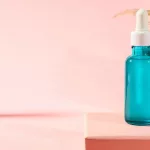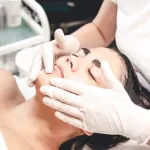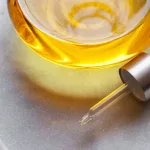If you’re familiar with skin-care actives, you probably know glycolic acid and retinol each deliver notable benefits to the skin.
What’s not always clear is that they operate differently.
Glycolic acid targets the surface, promoting exfoliation. Retinol works more deeply, improving texture and overall skin quality.
If you’ve been told you must pick one or the other, here’s some reassuring news: you don’t necessarily have to decide between them. You can include both in your regimen to get complementary results.
Below is a practical guide to getting the most from these two potent ingredients.
Benefits of glycolic acid
Glycolic acid is an alpha-hydroxy acid (AHA) sourced from sugar cane. It shows up in many formats, from cleansers and masks to peels and serums.
As a chemical exfoliant, glycolic acid helps refresh the complexion and even out discoloration, says board-certified dermatologist Dr. Anna Chacon.
It works by dissolving the “glue” that holds skin cells together, making it easier to slough off dead skin from the outermost layer.
By revealing newer skin beneath, glycolic acid also improves the absorption of subsequent products. Because of this, it can be useful for addressing acne and hyperpigmentation.
How to use
Over-the-counter formulations usually feature lower concentrations of glycolic acid, commonly up to 30 percent. Dermatologists may apply much stronger solutions during in-office chemical peels.
Product types come with different usage instructions, but these general tips are helpful:
- Lower-concentration cleansers can often be used daily.
- Stronger serums or treatments are typically used once or twice weekly.
- If your skin tolerates them well and you want further results, slowly increase frequency to three times a week or every other day.

Benefits of retinol
Retinol is a topical form of vitamin A.
Because retinol is less potent than prescription retinoids, it’s widely available over the counter in many skincare products.
“Retinol stimulates collagen production and promotes skin cell turnover,” Chacon explains.
These effects can soften the look of fine lines and wrinkles and help fade discoloration, making retinol particularly effective for anti-aging concerns compared with glycolic acid.
It can also clear clogged pores, which may reduce acne outbreaks.
How to use
Retinol can dry out skin, so begin gradually. Follow these pointers:
- Start with retinol once or twice a week.
- Apply it to cleansed skin, then follow with a nourishing moisturizer.
- Increase frequency to every other day as your skin builds tolerance and you don’t see irritation.
- Consider using retinol at night since it can heighten sensitivity to UV light during the first months of use.
- Be diligent about daily sunscreen application.
Is one better than the other?
Retinol and glycolic acid share overlapping benefits. Both can treat acne and offer anti-aging support.
Which is “better” depends on your goals and skin type.
Key benefits
Glycolic acid may be preferable if you have dry or sensitive skin because it’s often more hydrating and less prone to cause irritation. It’s also a good choice for dull, uneven skin or mild congestion.
Retinol can help plump skin and improve the appearance of wrinkles, sun damage, and acne scarring — making it a strong option for more mature-looking skin.
Chacon recommends including a bit of both in your routine when possible.
She shares that she uses retinol at night for acne control and rejuvenation, while favoring glycolic acid in cleansers and peels for occasional brightening.
Is it safe to use them together?
Historically, people were advised not to combine glycolic acid and retinol.
This caution came from the belief that AHAs or BHAs might reduce retinol’s effectiveness.
A 2015 study, however, indicates the two can work well together for treating acne scars.
Still, while they can be complementary, it’s usually unwise to layer them directly on top of each other — that may lead to significant irritation. Instead, use them at different times of day or on alternate days.
“I generally don’t use both simultaneously,” Chacon says. “I tend to include retinol in my evening serum and use glycolic acid in the morning cleanser or as a body lotion.”
How to use both
Follow these steps to incorporate both ingredients safely:
- Introduce retinol gradually — once weekly at first to test tolerance.
- Slowly increase retinol use to several times a week or every other day.
- Use glycolic acid on days you are not applying retinol.
- Raise glycolic acid frequency to every other day if your skin handles it.
If your skin tolerates both without dryness or irritation, you may eventually use one in the morning and the other at night.
Avoid applying vitamin C or other actives immediately after glycolic acid, and don’t combine glycolic acid with other AHAs to prevent adverse reactions.
If you have very dry or reactive skin, consult a dermatologist before adding these actives.
Risks and side effects
Both ingredients can cause side effects in some people.
Some reactions, like breakouts or swelling with retinol, are uncommon. Others, such as increased sun sensitivity, are more typical.
Most tolerate glycolic acid well, but experts advise avoiding retinoids, including retinol, during pregnancy and breastfeeding.
Speak with your dermatologist before using either ingredient if you have rosacea or other skin sensitivities.
Other risks include:
Sun sensitivity
Both retinol and glycolic acid can raise your skin’s sensitivity to sunlight.
Daily sunscreen use (and reapplication) helps minimize sunburn and long-term UV damage.
Peeling and flaking
Both actives can cause peeling and flaking, so proceed cautiously if your skin is dry or delicate.
This reaction is often temporary, but if flaking emerges, consider reducing frequency, switching to a milder formula, or discontinuing use. A dermatologist can recommend the best course for your skin.
Redness
Using too many exfoliants or active treatments can irritate the skin, causing redness, burning, or tightness.
Itchiness
If your skin can’t tolerate an ingredient, irritation and itching typically follow.
Stop use and consult your dermatologist or physician if you experience itchiness from glycolic acid or retinol before attempting them again.
Hyperpigmentation
Those with darker skin tones may be more prone to post-inflammatory hyperpigmentation from glycolic acid.
To reduce this risk:
- Opt for lower concentrations of glycolic acid.
- Avoid using multiple glycolic products simultaneously.
- Apply sunscreen and moisturize consistently.
- Don’t exfoliate or scrub right after using glycolic acid.
Choosing a product
Shopping for the right product?
Chacon suggests reading reviews and checking ingredient lists to ensure you aren’t sensitive or allergic to any component.
“Start with the lowest strength to minimize the chance of irritation or adverse effects,” she advises.
Some choices to consider:
If you’re new to these ingredients or have sensitive skin, avoid products that combine multiple actives like other acids or vitamin C.
The bottom line
Glycolic acid and retinol both rejuvenate skin, so either can provide the lift you’re seeking in your skincare routine.
Don’t overdo it: you can alternate days or use them at separate times, but begin slowly and seek professional advice if you see negative reactions.
If you experience persistent discomfort, or your concerns don’t improve, consult a dermatologist for individualized guidance.


















Leave a Reply
You must be logged in to post a comment.